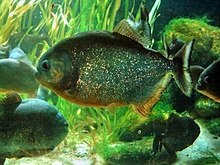Pygocentrus piraya, often called the piraya piranha or San Francisco piranha, and sometimes sold as the man-eating piranha, is a large, aggressive piranha from the São Francisco River basin in Brazil.
| Pygocentrus piraya | |
|---|---|

| |
| Scientific classification | |
| Domain: | Eukaryota |
| Kingdom: | Animalia |
| Phylum: | Chordata |
| Class: | Actinopterygii |
| Order: | Characiformes |
| Family: | Serrasalmidae |
| Genus: | Pygocentrus |
| Species: | P. piraya
|
| Binomial name | |
| Pygocentrus piraya | |
| Synonyms | |
|
Serrasalmus Piraya | |
This article relies largely or entirely on a single source. (March 2022) |
Description
editIt is one of the largest piranhas, reaching a maximum length of 50 cm in the wild, and is sometimes considered the most beautiful, with its orange to yellow belly coloration, silver eyes, and rayed fibrous adipose fin. Like most other piranhas, P. piraya is laterally compressed and roughly circular in profile, and bears a mouthful of very sharp teeth. The lower jaw is thick, strong, and protruding.
Names
editIt is known by many vernacular names, such as Rio São Francisco piranha, black-tailed piranha, and king emperor piranha, and locally it is simply termed piraya.
Diet
editThis fish is an omnivore, and has aggressive tendencies when hungry, stressed, or seeking live food. Like most in the Serrasalmidae family, piraya piranhas dental morphology has a major influence for their inclination toward piscivorous and herbivorous behavior[3]. Members of this genus bear one row of sharp, triangular teeth with a strong lower jaw, which enable them to slice and mince prey with ease[4]. This characteristic combined with its large size make it a danger to humans. Piranha's attacks on humans are anecdotal for the most part. The piranha mostly prefers to eat small fish and insects, along with seeds and aquatic plant material. The pygocentrus piraya plays a key role in their ecosystem by regulating the population of other fish[5]
In captivity
editThe piraya is sometimes available as an aquarium fish. It is not generally bred in captivity, so aquarium pirayas are usually imported from South America and can be expensive. Any other fish sharing a tank with a piraya should be of the same or a similar piranha species. Other types of fish will be attacked and eaten.
References
edit- ^ Instituto Chico Mendes de Conservação da Biodiversidade (ICMBio). (2022). "Pygocentrus piraya". IUCN Red List of Threatened Species. 2022: e.T186786A1818359. Retrieved 1 December 2022.
- ^ "Pygocentrus piraya". FishBase.
- ^ Delaunois, Yann; Huby, Alessia; Malherbe, Cédric; Eppe, Gauthier; Parmentier, Éric; Compère, Philippe (2020-06-01). "Microstructural and compositional variation in pacu and piranha teeth related to diet specialization (Teleostei: Serrasalmidae)". Journal of Structural Biology. 210 (3): 107509. doi:10.1016/j.jsb.2020.107509. ISSN 1047-8477.
- ^ Velasco-Hogan, Audrey; Meyers, Marc A. (2021-03-01). "Bite force mechanics and allometry of piranha (Serrasalmidae)". Journal of the Mechanical Behavior of Biomedical Materials. 115: 104296. doi:10.1016/j.jmbbm.2020.104296. ISSN 1751-6161.
- ^ SANTOS-CLAPP, M. D., DUARTE, R., ALBUQUERQUE, M. C., & BRASIL-SATO, M. C.. (2022). Helminth endoparasites of endemic fish Pygocentrus piraya (Characiformes, Serrasalmidae) from Três Marias reservoir, Minas Gerais, Brazil. Anais Da Academia Brasileira De Ciências, 94(4), e20201425. https://doi.org/10.1590/0001-3765202220201425
